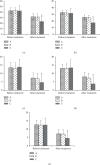Effect of Transdermal Fentanyl Patch Combined with Enhanced Recovery after Surgery on the Curative Effect and Analgesic Effect of Liver Cancer
- PMID: 35924273
- PMCID: PMC9343188
- DOI: 10.1155/2022/9722458
Effect of Transdermal Fentanyl Patch Combined with Enhanced Recovery after Surgery on the Curative Effect and Analgesic Effect of Liver Cancer
Retraction in
-
Retracted: Effect of Transdermal Fentanyl Patch Combined with Enhanced Recovery after Surgery on the Curative Effect and Analgesic Effect of Liver Cancer.Biomed Res Int. 2024 Jan 9;2024:9819217. doi: 10.1155/2024/9819217. eCollection 2024. Biomed Res Int. 2024. PMID: 38230067 Free PMC article.
Abstract
Its goal was to see how a transdermal fentanyl patch combined with accelerated recovery after surgery (ERAS) affected the treatment efficacy and analgesic effect of liver cancer, as well as to help patients with liver cancer choose the right analgesic treatment and nursing mode. 150 patients with liver cancer were divided into group A (transdermal fentanyl patch), group B (ERAS), and group C (transdermal fentanyl patch combined with ERAS). Patients in the three groups were compared in terms of pain, survival, psychological status, adverse responses, postoperative recovery, and patient satisfaction. The results showed that under different treatment and nursing methods, the number of patients with mild cancer pain in the three groups was increased, especially the number of patients with mild cancer pain in group C (P < 0.05). Besides, the quality of life score of patients in each group was decreased. Patients who received the combination analgesia had a significantly higher quality of life than those who received simply a transdermal fentanyl patch or ERAS (P < 0.05). The scores of both the Hamilton anxiety scale (HAMA) and Hamilton depression rating scale (HAMD) of patients with the combined analgesia were decreased signally (P < 0.05). There were few patients with combined analgesia who had adverse reactions (P < 0.05). After surgery, the time of the first anal exhaust, first defecation, and first ambulation in group C were shorter than those in the other two groups (P < 0.05). To summarize, combining the two techniques aided in the recovery of gastrointestinal function as well as the physical recovery of patients following surgery. Furthermore, combining the two approaches produced a clear analgesic impact, which could improve patients' quality of life while also having a favorable clinical adoption effect.
Copyright © 2022 Hengmei Zhu et al.
Conflict of interest statement
The authors declare no conflicts of interest.
Figures











Similar articles
-
Analgesic effect of switching from oral opioids to a once-a-day fentanyl citrate transdermal patch in patients with lung cancer.Am J Hosp Palliat Care. 2013 Nov;30(7):726-9. doi: 10.1177/1049909112470020. Epub 2012 Dec 21. Am J Hosp Palliat Care. 2013. PMID: 23264661
-
Transdermal fentanyl in postoperative pain.Reg Anesth. 1997 Jan-Feb;22(1):24-8. doi: 10.1016/s1098-7339(06)80052-0. Reg Anesth. 1997. PMID: 9010943 Clinical Trial.
-
Efficacy, safety and pharmacokinetic study of a novel fentanyl-containing matrix transdermal patch system in Japanese patients with cancer pain.Clin Drug Investig. 2008;28(5):313-25. doi: 10.2165/00044011-200828050-00005. Clin Drug Investig. 2008. PMID: 18407717 Clinical Trial.
-
Benefit-risk assessment of transdermal fentanyl for the treatment of chronic pain.Drug Saf. 2003;26(13):951-73. doi: 10.2165/00002018-200326130-00004. Drug Saf. 2003. PMID: 14583070 Review.
-
Transdermal fentanyl. A review of its pharmacological properties and therapeutic efficacy in pain control.Drugs. 1997 Jan;53(1):109-38. doi: 10.2165/00003495-199753010-00011. Drugs. 1997. PMID: 9010652 Review.
Cited by
-
Application of multi-perspective nursing based on the whole-course ERAS concept during laparoscopic fundoplication in patients with PPI-dependent gastroesophageal reflux disease.Afr Health Sci. 2025 Jun;25(2):161-167. doi: 10.4314/ahs.v25i2.21. Afr Health Sci. 2025. PMID: 40837664 Free PMC article. Clinical Trial.
-
Significance of prothrombin, activated partial thromboplastin, and thrombin times in early rehabilitation after tibial fracture surgery.Am J Transl Res. 2024 Sep 15;16(9):4894-4902. doi: 10.62347/XKLL3245. eCollection 2024. Am J Transl Res. 2024. PMID: 39398598 Free PMC article.
-
Retracted: Effect of Transdermal Fentanyl Patch Combined with Enhanced Recovery after Surgery on the Curative Effect and Analgesic Effect of Liver Cancer.Biomed Res Int. 2024 Jan 9;2024:9819217. doi: 10.1155/2024/9819217. eCollection 2024. Biomed Res Int. 2024. PMID: 38230067 Free PMC article.
References
Publication types
MeSH terms
Substances
LinkOut - more resources
Full Text Sources
Medical

